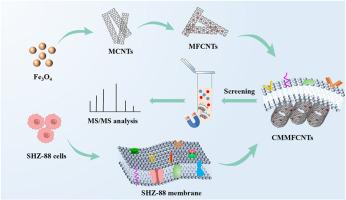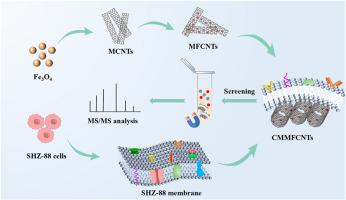通过逐层组装精确构建细胞膜仿生磁性荧光碳纳米平台,用于靶向捕获药物先导
IF 6
2区 化学
Q1 CHEMISTRY, ANALYTICAL
引用次数: 0
摘要
天然产物作为新药物发现的有效来源,在各种疾病的治疗中有着重要的贡献。病理细胞膜仿生改性磁性碳纳米平台在生物活性成分的靶向筛选方面显示出巨大的潜力。同时,细胞成像技术的引入使该平台在实时鉴定活性成分的药理活性方面具有重要优势。结果通过层层组装准确构建了乳腺癌细胞膜仿生复合材料(CMMFCNTs),并将其作为筛选蒙古蒲鲁英中潜在抗癌成分的药物发现平台。综合表征技术表明,合成的CMMFCNTs具有优异的磁性能(饱和磁化强度为42.51 emu·mg-1)和较高的吸附容量(17.53 μg·mg-1),并通过光谱和形态技术对其进行了表征。最后,准确地捕获了四种潜在的抗癌成分:根连素、马鞭草素、薯蓣皂苷和六氢姜黄素。分子对接表明,这些化合物与细胞膜受体(P-gp、HER2、ERα)之间具有较强的结合,结合能范围为-7.5至-9.1 kcal∙mol-1。通过细胞成像实验和伤口划伤实验,初步验证了其对乳腺癌细胞增殖的抑制作用。虽然在以往的研究中已经报道了细胞膜仿生筛选的各种应用,但细胞成像技术在其中的应用较少。此外,本研究还探讨了筛选到的活性成分与乳腺癌细胞膜相关受体的相互结合作用,进一步验证了筛选到的活性成分的潜在药理作用。综上所述,基于病理细胞膜模拟的磁性荧光碳纳米平台在复杂基质中有效成分筛选方面具有很大的前景,促进了基于天然产物的开发。本文章由计算机程序翻译,如有差异,请以英文原文为准。


Accurate construction of cell membrane biomimetic magnetic fluorescent carbon nanoplatform via layer-by-layer assembly for targeted capture of drug leads
Background
As an effective source of novel drug discovery, natural products have important contributions in the treatment of various diseases. Pathological cell membrane biomimetic modified magnetic carbon nano-platform shows great potential in targeted screening of bioactive ingredients. Meanwhile, the introduction of cellular imaging technology enables the platform to achieve important advantages in real-time identification of pharmacological activities of active ingredients.
Results
Breast cancer cell membrane biomimetic composites (CMMFCNTs) were accurately constructed via layer-by-layer assembly and utilized as a drug discovery platform to screen potential anti-cancer ingredients from Taraxacum mongolicum. Comprehensive characterization techniques indicated that the synthesized CMMFCNTs possessed excellent magnetic properties (saturation magnetization: 42.51 emu·g−1), high adsorption capacity (17.53 μg mg−1), and were well-characterized by spectroscopic and morphological techniques. Finally, four potential anti-cancer components: phlorizin, loganin, diosmetin, and hexahydrocurcumin were accurately captured. Molecular docking demonstrated strong binding between these compounds and cell membrane receptors (P-gp, HER2, ERα), supported by favorable binding energies (range: −7.5 to −9.1 kcal∙mol−1). Moreover, their inhibitory effects on the proliferation of breast cancer cells were preliminarily verified by cell imaging experiments and wound scratch assay.
Significance
Although various applications of cell membrane biomimetic screening have been reported in previous studies, cell imaging technology has been used less frequently in it. In addition, this study also explored the inter-binding effect of the screened active ingredients with breast cancer cell membrane-associated receptors to further validate the potential pharmacological effects of the screened active ingredients. In conclusion, magnetic fluorescent carbon nanoplatforms based on pathological cell membrane mimicry show great promise for active ingredients screening in complex matrices, facilitating natural product-based development.
求助全文
通过发布文献求助,成功后即可免费获取论文全文。
去求助
来源期刊

Analytica Chimica Acta
化学-分析化学
CiteScore
10.40
自引率
6.50%
发文量
1081
审稿时长
38 days
期刊介绍:
Analytica Chimica Acta has an open access mirror journal Analytica Chimica Acta: X, sharing the same aims and scope, editorial team, submission system and rigorous peer review.
Analytica Chimica Acta provides a forum for the rapid publication of original research, and critical, comprehensive reviews dealing with all aspects of fundamental and applied modern analytical chemistry. The journal welcomes the submission of research papers which report studies concerning the development of new and significant analytical methodologies. In determining the suitability of submitted articles for publication, particular scrutiny will be placed on the degree of novelty and impact of the research and the extent to which it adds to the existing body of knowledge in analytical chemistry.
 求助内容:
求助内容: 应助结果提醒方式:
应助结果提醒方式:


